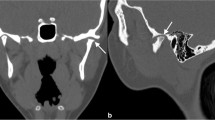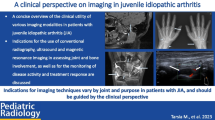Abstract
To assess the sequence and type of active joints in a cohort of newly diagnosed juvenile idiopathic arthritis (JIA) patients with full access to current treatment at first visit and during a follow-up period of 5-years, in order to identify an index joint/group of joints for magnetic resonance imaging in JIA. Patient charts of all consecutive newly diagnosed JIA patients with a follow-up duration of at least 5 years were analyzed. Patients were derived from two tertiary pediatric rheumatology centers. Patient characteristics and data concerning the presence of joints with arthritis and the use of medication were recorded. Findings from 95 JIA patients [39 (41 %) oligoarticular and 56 (59 %) polyarticular] were analyzed. At first visit, distribution of active joints among patients was as follows: knee (n = 70, 74 %), ankle (n = 55, 58 %), elbow (n = 23, 24 %), wrist (n = 23, 24 %), metacarpophalangeal (MCP) (n = 20, 21 %), proximal interphalangeal (PIP) (n = 13, 14 %), hip (n = 6, 6 %), shoulder (n = 5, 5 %), and distal interphalangeal (DIP) (n = 4, 4 %) joints. After a follow-up period of 5 years, the cumulative percentage of patients with specific joint involvement changed into: knee (n = 88, 93 %), ankle (n = 79, 83 %), elbow (n = 43, 45 %), wrist (n = 38, 40 %), MCP (n = 36, 38 %), PIP (n = 29, 31 %), shoulder (n = 20, 21 %), hip (n = 17, 19 %), and DIP (n = 9, 10 %) joints. Despite changes in treatment strategies over the years, the knee remains the most commonly involved joint at onset and during follow-up in JIA, followed by the ankle, elbow, and wrist. For the evaluation of outcome with MRI, the knee appears the most appropriate joint in JIA.




Similar content being viewed by others
References
Petty RE, Southwood TR, Manners P, Baum J, Glass DN, Goldenberg J, He X, Maldonado-Cocco J, Orozco-Alcala J, Prieur AM, Suarez-Almazor ME, Woo P (2004) International League of Associations for Rheumatology classification of juvenile idiopathic arthritis: second revision, Edmonton, 2001. J Rheumatol 31 (2):390–392
Heiligenhaus A, Heinz C, Edelsten C, Kotaniemi K, Minden K (2013) Review for disease of the year: epidemiology of juvenile idiopathic arthritis and its associated uveitis: the probable risk factors. Ocul Immunol Inflamm 21(3):180–191
Ravelli A, Martini A (2007) Juvenile idiopathic arthritis. Lancet 369(9563):767–778
Bechtold S, Simon D (2014) Growth abnormalities in children and adolescents with juvenile idiopathic arthritis. Rheumatol Int [Epub ahead of print]
Albers HM, Wessels JA, van der Straaten RJ, Brinkman DM, Suijlekom-Smit LW, Kamphuis SS, Girschick HJ, Wouters C, Schilham MW, le Cessie S, Huizinga TW, Ten Cate R, Guchelaar HJ (2009) Time to treatment as an important factor for the response to methotrexate in juvenile idiopathic arthritis. Arthritis Rheum 61(1):46–51
van Dijkhuizen EH, Wulffraat NM (2014) Early predictors of prognosis in juvenile idiopathic arthritis: a systematic literature review. Ann Rheum Dis. doi:10.1136/annrheumdis-2014-205265 [Epub ahead of print]
Bulatovic Calasan M, de Vries LD, Vastert SJ, Heijstek MW, Wulffraat NM (2014) Interpretation of the Juvenile Arthritis Disease Activity Score: responsiveness, clinically important differences and levels of disease activity in prospective cohorts of patients with juvenile idiopathic arthritis. Rheumatology (Oxford) 53(2):307–312
Miller E, Uleryk E, Doria AS (2009) Evidence-based outcomes of studies addressing diagnostic accuracy of MRI of juvenile idiopathic arthritis. AJR Am J Roentgenol 192(5):1209–1218
Hemke R, van Rossum MA, van Veenendaal M, Terra MP, Deurloo EE, de Jonge MC, van den Berg JM, Dolman KM, Kuijpers TW, Maas M (2012) Reliability and responsiveness of the Juvenile Arthritis MRI Scoring (JAMRIS) system for the knee. Eur Radiol 23(4):1075–1083
Østergaard M, Peterfy C, Conaghan P, McQueen F, Bird P, Ejbjerg B, Shnier R, O’Connor P, Klarlund M, Emery P, Genant H, Lassere M, Edmonds J (2003) OMERACT rheumatoid arthritis magnetic resonance imaging studies. Core set of MRI acquisitions, joint pathology definitions, and the OMERACT RA-MRI scoring system. J Rheumatol 30(6):1385–1386
Bertilsson L, Andersson-Gare B, Fasth A, Forsblad-d’Elia H (2012) A 5-year prospective population-based study of juvenile chronic arthritis: onset, disease process, and outcome. Scand J Rheumatol 41(5):379–382
Al-Matar MJ, Petty RE, Tucker LB, Malleson PN, Schroeder ML, Cabral DA (2002) The early pattern of joint involvement predicts disease progression in children with oligoarticular (pauciarticular) juvenile rheumatoid arthritis. Arthritis Rheum 46(10):2708–2715
Wallace CA, Ruperto N, Giannini E (2004) Preliminary criteria for clinical remission for select categories of juvenile idiopathic arthritis. J Rheumatol 31(11):2290–2294
Albers HM, Brinkman DM, Kamphuis SS, van Suijlekom-Smit LW, van Rossum MA, Hoppenreijs EP, Girschick HJ, Wouters C, Saurenmann RK, Houwing-Duistermaat JJ, Huizinga TW, Schilham MW, ten Cate R (2010) Clinical course and prognostic value of disease activity in the first two years in different subtypes of juvenile idiopathic arthritis. Arthritis Care Res (Hoboken) 62(2):204–212
Oen K, Malleson PN, Cabral DA, Rosenberg AM, Petty RE, Cheang M (2002) Disease course and outcome of juvenile rheumatoid arthritis in a multicenter cohort. J Rheumatol 29(9):1989–1999
Wallace CA, Huang B, Bandeira M, Ravelli A, Giannini EH (2005) Patterns of clinical remission in select categories of juvenile idiopathic arthritis. Arthritis Rheum 52(11):3554–3562
Vilca I, Munitis PG, Pistorio A, Ravelli A, Buoncompagni A, Bica B, Campos L, Hafner R, Hofer M, Ozen S, Huemer C, Bae SC, Sztajnbok F, Arguedas O, Foeldvari I, Huppertz HI, Gamir ML, Magnusson B, Dressler F, Uziel Y, van Rossum MA, Hollingworth P, Cawkwell G, Martini A, Ruperto N (2010) Pediatric rheumatology international trials o predictors of poor response to methotrexate in polyarticular-course juvenile idiopathic arthritis: analysis of the PRINTO methotrexate trial. Ann Rheum Dis 69(8):1479–1483
Guillaume S, Prieur AM, Coste J, Job-Deslandre C (2000) Long-term outcome and prognosis in oligoarticular-onset juvenile idiopathic arthritis. Arthritis Rheum 43(8):1858–1865
Leksell E, Ernberg M, Magnusson B, Hedenberg-Magnusson B (2012) Orofacial pain and dysfunction in children with juvenile idiopathic arthritis: a case-control study. Scand J Rheumatol 41(5):375–378
Twilt M, Mobers SM, Arends LR, ten Cate R, van Suijlekom-Smit L (2004) Temporomandibular involvement in juvenile idiopathic arthritis. J Rheumatol 31(7):1418–1422
Kuseler A, Pedersen TK, Gelineck J, Herlin T (2005) A 2 year followup study of enhanced magnetic resonance imaging and clinical examination of the temporomandibular joint in children with juvenile idiopathic arthritis. J Rheumatol 32(1):162–169
Giannini EH, Ruperto N, Ravelli A, Lovell DJ, Felson DT, Martini A (1997) Preliminary definition of improvement in juvenile arthritis. Arthritis Rheum 40(7):1202–1209
Wallace CA, Giannini EH, Huang B, Itert L, Ruperto N (2011) American College of Rheumatology provisional criteria for defining clinical inactive disease in select categories of juvenile idiopathic arthritis. Arthritis Care Res (Hoboken) 63(7):929–936
Guzman J, Burgos-Vargas R, Duarte-Salazar C, Gomez-Mora P (1995) Reliability of the articular examination in children with juvenile rheumatoid arthritis: interobserver agreement and sources of disagreement. J Rheumatol 22(12):2331–2336
Magni-Manzoni S, Malattia C, Lanni S, Ravelli A (2012) Advances and challenges in imaging in juvenile idiopathic arthritis. Nat Rev Rheumatol 8(6):329–336
Malattia C, Damasio MB, Pistorio A, Ioseliani M, Vilca I, Valle M, Ruperto N, Viola S, Buoncompagni A, Magnano GM, Ravelli A, Toma P, Martini A (2011) Development and preliminary validation of a paediatric-targeted MRI scoring system for the assessment of disease activity and damage in juvenile idiopathic arthritis. Ann Rheum Dis 70(3):440–446
Martini A (2012) It is time to rethink juvenile idiopathic arthritis classification and nomenclature. Ann Rheum Dis 71(9):1437–1439
Author information
Authors and Affiliations
Corresponding author
Rights and permissions
About this article
Cite this article
Hemke, R., Nusman, C.M., van der Heijde, D.M.F.M. et al. Frequency of joint involvement in juvenile idiopathic arthritis during a 5-year follow-up of newly diagnosed patients: implications for MR imaging as outcome measure. Rheumatol Int 35, 351–357 (2015). https://doi.org/10.1007/s00296-014-3108-x
Received:
Accepted:
Published:
Issue Date:
DOI: https://doi.org/10.1007/s00296-014-3108-x




